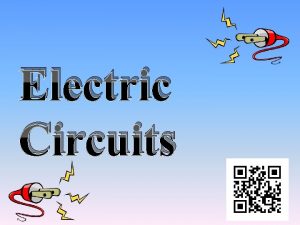Comparing Experts and Novices In Solving Electrical Circuit

- Slides: 1

Comparing Experts and Novices In Solving Electrical Circuit Problems With the Help of Eye-Tracking David Rosengrant, Colin Thomson & Taha Mzoughi Department of Biology and Physics, Kennesaw State University th AAPT / PERC 2008 – Ann Arbor, Michigan, July 29 2009 Abstract Sample In order to help introductory physics students understand learn to solve problems with circuits, we must first understand how they differ from experts. This preliminary study focuses on problem-solving dealing with electrical circuits. We investigate difficulties novices have with circuits and compare their work with those of experts. We incorporate the use of an eye-tracker to investigate any possible differences or similarities on how experts and novices focus on graphics or multimedia usually used in analyzing circuits and their components. Our results show similarities in gaze patterns among all subjects on the components of the circuit. We also found differences in how they solve the problems. For example, experts simplified circuits when appropriate as opposed to novices who did not. We also found that novices were confusing additive properties of capacitance with those of resistance. They also had difficulties identifying when resistors are in parallel or in series. The study was conducted in the second semester of a 44 student two-semester introductory algebra based physics course. The students in this course studied electro-statics which included capacitance networks, circuits, magnetism, waves and optics. Students studied electrical circuits and how to construct/simplify them with simulations as part of lab and prelab activities. Eleven subjects participated in this study. Nine were students in the above course who we considered novices. The other two were physics faculty members at the university who we consider the experts. Circuits Given to Students Questions Asked Equipment For circuits 1 through 3 we asked the subjects to calculate the net resistance of the circuit. We asked the subjects questions comparing current flow through different resistors in circuits 1 and 2 as well as questions about the potential drop across several of the resistors. We asked a series of questions involving scenarios that would create short circuits in circuit 2 and scenarios about the effects of adding resistors for circuit 3. Finally, we asked one question in circuit 4 involving the potential difference between points A and B. We also varied the situation for each circuit beyond the questions. We gave the subjects a calculator with each circuit. For circuit 2 we also gave the subjects a direct current Phet Simulation that was a blank work area. For circuit 3 we added two simulations of the circuit, one Phet and one Physlet. Circuit 4 contained only the circuit, no simulations. We gave the subjects a series of questions based on the 4 circuits of increasing complexity shown above. Some of the questions required only an auditory response while others may have required them to write out their work using a graphic tablet monitor. They wore a head mounted eye-tracker while they answered the questions (middle right). The eye tracker was an Applied Science Laboratories Model 6000 Mobile Control Unit that included an Applied Science Laboratories head-mounted optics unit with scene camera. The eye tracker provided a video showing us what the subjects focused on while they answered our questions. A sample screen shot is to the right. Novice Scan-Path Findings 1. 2. 3. 4. 5. 6. 7. Novices confused rules of resistors and capacitors. Novices had difficulty understanding what components are in parallel and series. Novices were reluctant to construct new and simplified circuits. Experts labeled simplified circuits Novices were over reliant on Ohm’s Law. Novices believed you need a higher current to get a past a higher resistance. Novices also believed the higher the resistance the higher the voltage drop regardless of the arrangement. 8. Novices believed that current splits up evenly among path regardless of resistors in the path 9. One novice heavily reliant on simulations 10. Eye tracking data shows us experts turned attention between work and circuits 11. Eye tracking data shows us novices did not , only back and forth in their work. 12. Eye tracking data shows us in one instance expert followed path of current Expert Scan-Path

